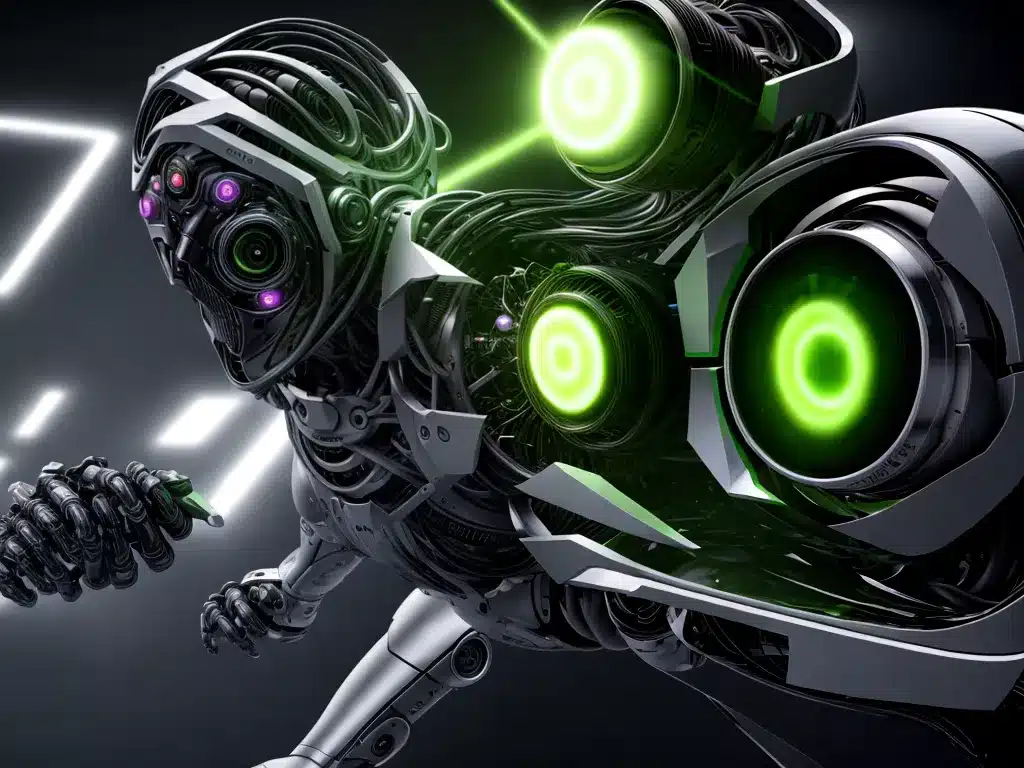
Nvidia’s Omniverse platform is a game-changer for graphics workflows using AI. Powered by Nvidia RTX technology, Omniverse allows creators to easily collaborate and share 3D assets and scenes across different software applications and platforms.
What is Nvidia Omniverse?
Omniverse is a real-time 3D design collaboration and virtual world simulation platform. It provides the fundamental technologies needed to connect 3D workflows across multiple software applications and platforms.
Omniverse is built on top of two key technologies:
-
Nvidia RTX – provides GPU-accelerated ray tracing, AI, and simulation. This enables real-time photorealistic rendering and physical simulations.
-
USD (Universal Scene Description) – an open standard file format for describing 3D scenes and assets. Supports Pixar’s Hydra rendering framework. Allows assets to be easily shared across applications.
With Omniverse, creators can collaborate simultaneously on a 3D scene while using different software tools like Maya, Blender, Houdini, etc. The changes are synchronized in real-time via the cloud.
Key Features of Omniverse
Some of the key capabilities provided by Omniverse include:
1. Real-Time Collaboration
-
Allows multiple creators to work on a 3D scene simultaneously from anywhere in the world.
-
Changes are synchronized automatically via the cloud. No need to manually transfer model and scene files.
-
Supports major 3D software like Maya, Blender, 3ds Max, Houdini. Unified via USD file format.
2. Physically Based Rendering
-
Provides photorealistic real-time rendering and ray tracing by harnessing Nvidia RTX GPUs.
-
Replicates real-world physical lighting, materials, and interactions.
-
Allows previewing of final render quality interactively. Reduces trial and error.
3. AI-Assisted Workflows
-
Uses AI to assist in tasks like motion tracking, object placement, 3D scanning, material editing etc.
-
Train AI models on your own data using Nvidia Deep Learning plugins.
-
Significantly speeds up graphics workflows.
4. Multi-GPU Scalability
-
Scales across multiple GPUs for handling complex 3D scenes.
-
Allows real-time collaboration and rendering of massive 3D environments with billions of polygons.
-
Makes workflows for large scenes, like in film production, much more efficient.
Key Use Cases
Some of the main use cases where Omniverse delivers value:
Digital Content Creation
- Special effects for films, animation, gaming environments etc.
-
Product design – cars, buildings, consumer electronics.
-
Allows multiple artists to simultaneously work on assets and shots. Changes are synced automatically. Saves time compared to manual transfers.
-
Photorealistic rendering in real-time previews instead of waiting for final renders.
Digital Twins and Simulations
-
Creating interactive digital twins of factories, buildings, cities etc.
-
Simulating real world physics – fire, smoke, water, destruction etc.
-
Running simulations to test prototypes and designs virtually. Adjusting parameters in real time.
Metaverse Development
-
Developing immersive and persistent virtual worlds and metaverse environments.
-
Import full 3D scenes from major 3D software. Make changes and enhancements within Omniverse.
-
Multi-GPU scalability to handle massive environments with billions of 3D objects.
Integrations with Leading 3D Software
Omniverse provides live synchronization of 3D scenes across the most popular 3D content creation tools:
-
Autodesk Maya – updates assets, camera, lighting, materials etc.
-
Blender – full scene and asset synchronization.
-
3ds Max – synchronization of cameras, geometry, materials.
-
Cinema4D – assets, splines, cameras stay in sync.
-
Houdini – materials, cameras, and scene updates in real-time.
-
Unity, Unreal Engine – game engine integrations.
The USD file format enables two-way transport of complete 3D scenes between these tools and Omniverse. This is a major improvement over manual and error-prone transfer of assets.
Democratizing Professional 3D Workflows
Nvidia Omniverse delivers several advantages over traditional 3D graphics pipelines:
-
Collaborative workflows allow anyone to contribute from anywhere in the world.
-
Real-time previews and iterative adjustment replace final test renders.
-
AI assistance makes complex tasks like animation faster.
-
Cloud-based asset sharing reduces duplication of work.
This helps democratize professional quality 3D workflows by making them more accessible. Artists can iterate faster and achieve better results.
Omniverse represents the cutting edge of 3D content creation pipelines by unifying workflows across tools. With continuing advancements in real-time ray tracing and AI, Omniverse has huge potential to become an integral platform for 3D artists and creators worldwide.












